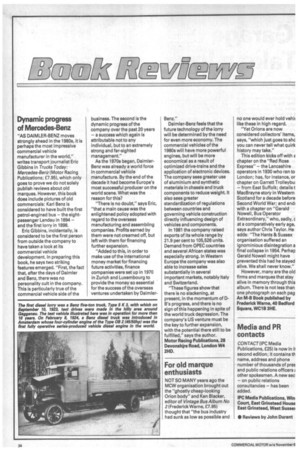Dynamic progress of Mercedes-Benz
Page 18

If you've noticed an error in this article please click here to report it so we can fix it.
"AS DAIMLER-BENZ moves strongly ahead in the 1980s, it is perhaps the most impressive commercial vehicle manufacturer in the world," writes transport journalist Eric Gibbins in Trucks Today: Mercedes-Beni (Motor Racing Publications; f7.95), which only goes to prove we do not solely publish reviews about old marques. However, this book does include pictures of old commercials: Karl Benz is considered to have built the first petrol-engined bus — the eightpassenger Landau in 1894 — and the first lorry in 1898.
Eric Gibbins, incidentally, is considered to be the first person from outside the company to have taken a look at its commercial vehicle development. In preparing this book, he says two striking features emerged. "First, the fact that, after the days of Daimler and Benz, there was no personality cult in the company. This is particularly true of the commercial vehicle side of the business. The second is the dynamic progress of the company over the past 20 years — a success which again is attributable not to any individual, but to an extremely strong and far-sighted management."
As the 1970s began, DaimlerBenz was already a world force in commercial vehicle manufacture. By the end of the decade it had become Europe's most successful producer on the world scene. What was the reason for this?
"There is no doubt," says Eric, "that a main cause was the enlightened policy adopted with regard to the overseas manufacturing and assembling companies. Profits earned by them were not creamed off, but left with them for financing further expansion.
"Added to this, in order to make use of the international money market for financing future activities, finance companies were set up in 1970 in Zurich and Luxembourg to provide the money so essential for the success of the overseas ventures undertaken by Daimler Benz."
Daimler-Benz feels that the future technology of the lorry will be determined by the need for even more economy. The commercial vehicles of the 1980s will have more powerful engines, but will be more economical as a result of optimized drive-trains and the application of electronic devices. The company sees greater use of aluminium and synthetic materials in chassis and truck components to reduce weight. It also sees greater standardization of regulations between countries and governing vehicle construction directly influencing design of vehicles and components.
In 1981 the company raised exports of its whole range by 21.9 per cent to 105,526 units. Demand from OPEC countries and several African states was especially strong. In Western Europe the company was also able to increase sales substantially in several important markets, notably Italy and Switzerland.
"These figures show that there is no slackening, at present, in the momentum of DB's progress, and there is no sign of this happening in spite of the world truck depression. The company's US venture must be the key to further expansion, with the potential there still to be fulfilled," says the author. Motor Racing Publications, 28 Devonshire Road, London W4 2HD.
For old marque enthusiasts
NOT SO MANY years ago the MCW organisation brought out the "ghostly cheap-looking Orion body" and Ken Blacker, editor of Vintage Bus Album No 2 (Frederick Warne, £7.95) thought that "the bus industry had sunk as low as possible and
no one would ever hold vehi( like these in high regard.
"Yet Orions are now considered collectors' items, says, "which just goes to shc you can never tell what quirk history may take."
This edition kicks off with a chapter on the "Red Rose Express" — the Lancashire operators in 1930 who ran to London; has, for instance, or chapter on Garrett Trolleybu! — from East Suffolk; details t MacBrayne story in Western Scotland for a decade before Second World War; and end: with a chapter on "Gerald Nowell, Bus Operator Extraordinary," who, sadly, c at a comparatively early age, says author Chris Taylor. He adds: "The Hants & Sussex organisation suffered an ignominious disintegration a final collapse in 1954. Perhap Gerald Nowell might have prevented this had he stayed alive. We shall never know."
However, many are the old firms and marques that stay alive in memory through this album. There is not less than one photograph on each pag An M-B Book published by Frederick Warne, 40 Bedford Square, WC1B 3HE.
Media and PR contacts
CONTACT (IPC Media Publications, £25) is now in ii second edition; it contains th name, address and phone
• number of thousands of pores and public relations officers other spokesmen. A new sec — on public relations consultancies — has been added.








































